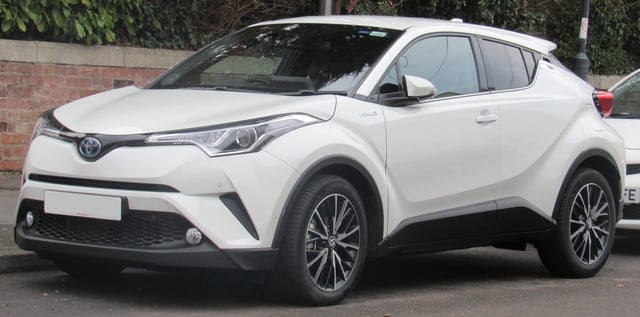Toyota

Toyota

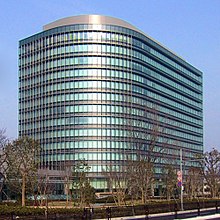 Toyota's headquarters in Toyota City, Japan | |
Native name | トヨタ自動車株式会社 |
|---|---|
Romanized name | Toyota Jidosha KK |
Type | Public (K.K) |
| Traded as | |
| ISIN | JP3633400001 [286] |
| Industry | Automotive |
| Founded | 28 August 1937 (1937-08-28) |
| Founder | Kiichiro Toyoda |
| Headquarters | Toyota City, Japan |
Area served | Worldwide |
Key people |
|
| Products | Automobiles, luxury vehicles, commercial vehicles, engines |
Production output | |
| Services | Banking, financing, leasing |
| Revenue | |
Operating income | |
Net income | |
| Total assets | |
| Total equity | |
Number of employees | |
| Divisions |
|
| Subsidiaries | 606[4] List
|
| Website | toyota-global.com [287] |
Toyota Motor Corporation (Japanese: トヨタ自動車株式会社, Hepburn: Toyota Jidōsha KK, IPA: [toꜜjota], English: /tɔɪˈoʊtə/) is a Japanese multinational automotive manufacturer headquartered in Toyota, Aichi, Japan. In 2017, Toyota's corporate structure consisted of 364,445 employees worldwide[5] and, as of September 2018, was the sixth-largest company in the world by revenue. As of 2017, Toyota is the largest automotive manufacturer. Toyota was the world's first automobile manufacturer to produce more than 10 million vehicles per year which it has done since 2012, when it also reported the production of its 200-millionth vehicle.[6] As of July 2014, Toyota was the largest listed company in Japan by market capitalization (worth more than twice as much as number 2-ranked SoftBank)[7] and by revenue.[8][9]
Toyota is the world's market leader in sales of hybrid electric vehicles, and one of the largest companies to encourage the mass-market adoption of hybrid vehicles across the globe. Toyota is also a market leader in hydrogen fuel-cell vehicles. Cumulative global sales of Toyota and Lexus hybrid passenger car models achieved the 10 million milestone in January 2017. Its Prius family is the world's top selling hybrid nameplate with over 6 million units sold worldwide as of January 2017.[10]
The company was founded by Kiichiro Toyoda in 1937, as a spinoff from his father's company Toyota Industries to create automobiles. Three years earlier, in 1934, while still a department of Toyota Industries, it created its first product, the Type A engine, and its first passenger car in 1936, the Toyota AA. Toyota Motor Corporation produces vehicles under five brands, including the Toyota brand, Hino, Lexus, Ranz, and Daihatsu. It also holds a 16.66% stake in Subaru Corporation, a 5.9% stake in Isuzu, a 5.5% stake in Mazda, as well as joint-ventures with two in China (GAC Toyota and Sichuan FAW Toyota Motor), one in India (Toyota Kirloskar), one in the Czech Republic (TPCA), along with several "nonautomotive" companies.[11] TMC is part of the Toyota Group, one of the largest conglomerates in Japan.
Toyota is listed on the London Stock Exchange, New York Stock Exchange and Tokyo Stock Exchange.
 Toyota's headquarters in Toyota City, Japan | |
Native name | トヨタ自動車株式会社 |
|---|---|
Romanized name | Toyota Jidosha KK |
Type | Public (K.K) |
| Traded as | |
| ISIN | JP3633400001 [286] |
| Industry | Automotive |
| Founded | 28 August 1937 (1937-08-28) |
| Founder | Kiichiro Toyoda |
| Headquarters | Toyota City, Japan |
Area served | Worldwide |
Key people |
|
| Products | Automobiles, luxury vehicles, commercial vehicles, engines |
Production output | |
| Services | Banking, financing, leasing |
| Revenue | |
Operating income | |
Net income | |
| Total assets | |
| Total equity | |
Number of employees | |
| Divisions |
|
| Subsidiaries | 606[4] List
|
| Website | toyota-global.com [287] |
Corporate governance
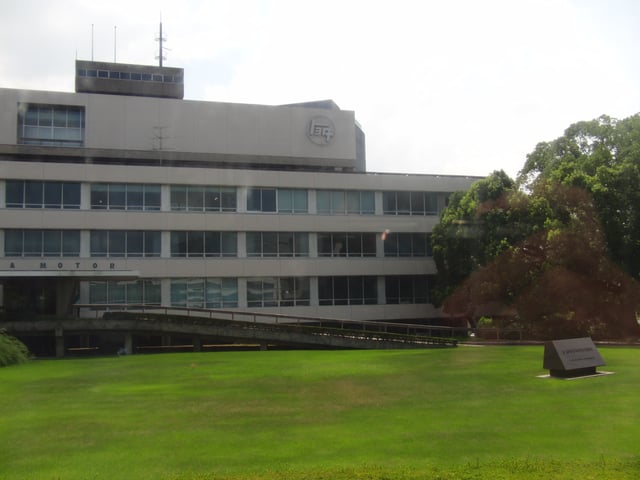
Principal headquarters building of Toyota
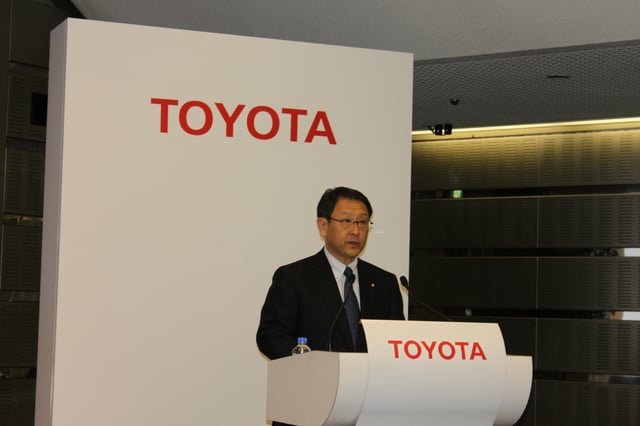
Akio Toyoda, CEO of Toyota, at the annual results press conference, May 11, 2011

Toyota's global network:Red – Japan Green – Official dealership(s) present. Blue – Localized manufacturing plant(s) Cyan – Regional headquarters (HQ) Purple – Regional headquarters (HQ) and localized manufacturing plants
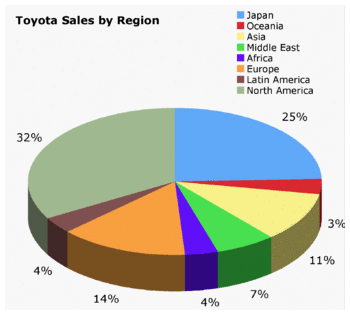
Typical breakdown of sales by region
Toyota is headquartered in Toyota City, Aichi.[12] The main headquarters of Toyota is located in a four-story building in Toyota. As of 2006, the head office has the "Toyopet" Toyota logo and the words "Toyota Motor". The Toyota Technical Center, a 14-story building, and the Honsha plant, Toyota's second plant engaging in mass production and formerly named the Koromo plant, are adjacent to one another in a location near the headquarters. Vinod Jacob from The Hindu described the main headquarters building as "modest".[13] In 2013, company head Akio Toyoda reported that it had difficulties retaining foreign employees at the headquarters due to the lack of amenities in the city.[14]
Its Tokyo office is located in Bunkyo, Tokyo. Its Nagoya office is located in Nakamura-ku, Nagoya.[12] In addition to manufacturing automobiles, Toyota provides financial services through its Toyota Financial Services division, and also builds robots.
Presidents of Toyota Motor Company:
Rizaburo Toyoda (1937–1941)
Kiichiro Toyoda (1941–1950)
Taizo Ishida (1950–1961)
Fukio Nakagawa (1961–1967)
Eiji Toyoda (1967–1982)
In 1981, Toyota Motor Co., Ltd. announced plans to merge with its sales entity Toyota Motor Sales Co., Ltd. Since 1950, the two entities had existed as separate companies as a prerequisite for reconstruction in postwar Japan. Shoichiro Toyoda presided over Toyota Motor Sales in preparation for the consummation of the merger that occurred in 1982. Shoichiro then succeeded his uncle Eiji as the president of the combined organization that then became known as Toyota Motor Corporation.
Presidents of Toyota Motor Corporation:
Chairmen of Toyota Motor Corporation:
Shoichiro Toyoda (1992–1999)
Hiroshi Okuda (1999–2006)
Fujio Cho (2006–2013)
Takeshi Uchiyamada (2013–present)
On June 14, 2013, Toyota Motor Corporation. announced the appointment of external board members; this was a first for the corporation and occurred following approval from general shareholders at a meeting on the same day. Additionally, Vice Chairman Takeshi Uchiyamada replaced Fujio Cho as chairman, as the latter became an honorary chairman while Toyoda remains in the post of president.[16]
Toyota is publicly traded on the Tokyo, Osaka, Nagoya, Fukuoka, and Sapporo exchanges under company code TYO: 7203 [288] . In addition, Toyota is foreign-listed on the New York Stock Exchange under NYSE: TM [289] and on the London Stock Exchange under LSE: TYT [290] . Toyota has been publicly traded in Japan since 1949 and internationally since 1999.[17]
As reported on its consolidated financial statements, Toyota has 606 consolidated subsidiaries and 199 affiliates.[4]
Toyota Motor North America (100% – 2004)
Toyota Canada Inc. (51% – 2013)
Toyota Tsusho – Trading company for the Toyota Group
Daihatsu Motor Company (100%)
Hino Motors (50.1% – 2001)
Lexus 100% (1989)
Scion 100% (2003)
DENSO (24.74% – September 30, 2006)
Toyota Industries (23.51% – March 31, 2006)
Aisin Seiki Co. (23.0% – September 30, 2006)
Subaru Corporation (16.66% – June 28, 2008)
Isuzu Motors (5.9% – November 10, 2006)
PT Toyota Astra Motor (50% – 2017)
Noble Automotive (23% – 2014)
PT Toyota Motor Manufacturing Indonesia[18] (95% – 2003)
Global ranking
Toyota, which earlier was the world's third largest automotive manufacturer behind American General Motors and Ford, produced for the first time in history more vehicles than Ford in 2005, and in 2006 even more than General Motors and has been the world's largest automotive manufacturer since then, except in 2011 when, triggered by the 2011 Tōhoku earthquake and tsunami, it fell to the number 3 position behind General Motors and German Volkswagen Group.
History
1920s–1930s

The mass-produced Toyoda automated loom, displayed at Toyota Museum in Aichi-gun, Japan

Toyoda Standard Sedan AA 1936
In 1924, Sakichi Toyoda invented the Toyoda Model G Automatic Loom. The principle of jidoka, which means the machine stops itself when a problem occurs, became later a part of the Toyota Production System. Looms were built on a small production line. In 1929, the patent for the automatic loom was sold to the British company Platt Brothers,[19] generating the starting capital for automobile development.[20]
The production of Toyota automobiles was started in 1933 as a division of Toyoda Automatic Loom Works devoted to the production of automobiles under the direction of the founder's son, Kiichiro Toyoda.[21] Its first vehicles were the A1 passenger car and the G1 truck in 1935. The Toyota Motor Company was established as an independent company in 1937 Vehicles were originally sold under the name "Toyoda" (トヨダ), from the family name of the company's founder, Kiichirō Toyoda. In April 1936, Toyoda's first passenger car, the Model AA, was completed. The sales price was 3,350 yen, 400 yen cheaper than Ford or GM cars.[22]
In September 1936, the company ran a public competition to design a new logo. Of 27,000 entries, the winning entry was the three Japanese katakana letters for "Toyoda" in a circle. However, Rizaburo Toyoda, who had married into the family and was not born with that name, preferred "Toyota" (トヨタ) because it took eight brush strokes (a lucky number) to write in Japanese, was visually simpler (leaving off the diacritic at the end), and with a voiceless consonant instead of a voiced one (voiced consonants are considered to have a "murky" or "muddy" sound compared to voiceless consonants, which are "clear").
1940s–1950s
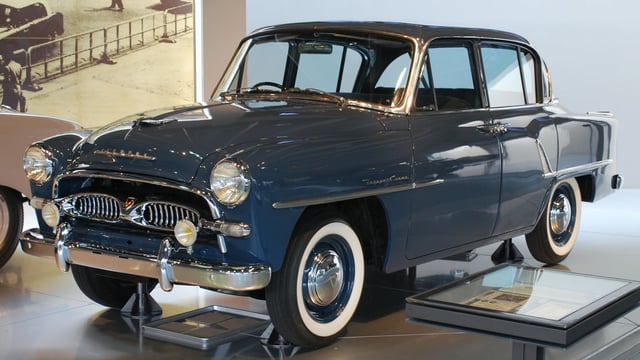
First-generation Toyopet Crown Model RSD (1955/1 – 1958/10)
From September 1947, Toyota's small-sized vehicles were sold under the name "Toyopet" (トヨペット).[26] The first vehicle sold under this name was the Toyopet SA,[27] but it also included vehicles such as the Toyopet SB light truck, Toyopet Stout light truck,[28] Toyopet Crown, Toyopet Master, and the Toyopet Corona. The word "Toyopet" (Japanese article) was a nickname given to the Toyota SA due to its small size, as the result of a naming contest the Toyota Company organized in 1947. However, when Toyota eventually entered the American market in 1957 with the Crown, the name was not well received due to connotations of toys and pets.[29] The name was soon dropped for the American market, but continued in other markets until the mid-1960s.
1960s–1970s
By the early 1960s, the US had begun placing stiff import tariffs on certain vehicles. The so-called "chicken tax" of 1964 placed a 25% tax on imported light trucks.[30] In response to the tariff, Toyota, Nissan Motor Co. and Honda Motor Co. began building plants in the US by the early 1980s.[30]
1980s
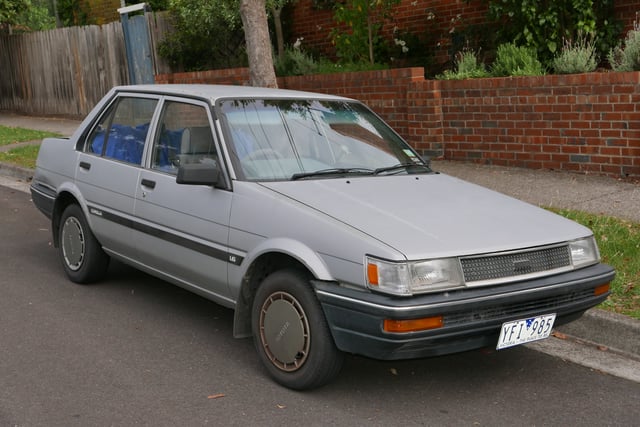
By the 1980s Toyota Corolla was one of the most popular and best selling cars in the world
Toyota received its first Japanese Quality Control Award at the start of the 1980s and began participating in a wide variety of motorsports. Due to the 1973 oil crisis, consumers in the lucrative US market began turning to making small cars with better fuel economy. American car manufacturers had considered small economy cars to be an entry-level product, and their small vehicles employed a low level of quality to keep the price low. Conservative Toyota held on to rear-wheel-drive designs for longer than most; while a clear first in overall production they were only third in production of front-wheel-drive cars in 1983, behind Nissan and Honda. In part due to this, Nissan's Sunny managed to squeeze by the Corolla in numbers built that year.[31]
In 1982, the Toyota Motor Company and Toyota Motor Sales merged into one company, the Toyota Motor Corporation. Two years later, Toyota entered into a joint venture with General Motors called the New United Motor Manufacturing, Inc, NUMMI, operating an automobile-manufacturing plant in Fremont, California. The factory was an old General Motors plant that had been closed for two years. It is currently the site of Tesla, Inc.'s assembly plant. Toyota then started to establish new brands at the end of the 1980s, with the launch of their luxury division Lexus in 1989.
1990s

Toyota Supra (JZA80) is one of the most recognized Japanese sports cars
In the 1990s, Toyota began to branch out from producing mostly compact cars by adding many larger and more luxurious vehicles to its lineup, including a full-sized pickup, the T100 (and later the Tundra), several lines of SUVs, a sport version of the Camry, known as the Camry Solara. They would also launch newer iterations of their sports cars, namely the MR2, Celica, and Supra during this era.
With a major presence in Europe, due to the success of Toyota Team Europe, the corporation decided to set up Toyota Motor Europe Marketing and Engineering, TMME, to help market vehicles in the continent. Two years later, Toyota set up a base in the United Kingdom, TMUK, as the company's cars had become very popular among British drivers. Bases in Indiana, Virginia, and Tianjin were also set up. In 1999, the company decided to list itself on the New York and London Stock Exchanges.
2000s
In 2001, Toyota's Toyo Trust and Banking merged with two other banks to form UFJ Bank, which was accused of corruption by Japan's government for making bad loans to alleged Yakuza crime syndicates with executives accused of blocking Financial Service Agency inspections.[32] The UFJ was listed among *Fortune Magazine'*s largest money-losing corporations in the world, with Toyota's chairman serving as a director.[33] At the time, the UFJ was one of the largest shareholders of Toyota. As a result of Japan's banking crisis, UFJ merged with the Bank of Tokyo-Mitsubishi to become the Mitsubishi UFJ Financial Group.
In 2002, Toyota managed to enter a Formula One works team and establish joint ventures with French motoring companies Citroën and Peugeot a year after Toyota started producing cars in France.
A youth-oriented marque for North America, Scion, was introduced in 2003.
In 2007, Toyota released an update of its full-sized truck, the Tundra, produced in two American factories, one in Texas and one in Indiana. Motor Trend named the Tundra "Truck of the Year", and the 2007 Toyota Camry "Car of the Year" for 2007. It also began the construction of two new factories, one to build the RAV4 in Woodstock, Ontario, Canada, and the other to build the Toyota Prius in Blue Springs, Mississippi, USA. This plant was originally intended to build the Toyota Highlander, but Toyota decided to use the plant in Princeton, Indiana, USA, instead. The company has also found recent success with its smaller models—the Corolla and Yaris.
2010s
In 2011, Toyota, along with large parts of the Japanese automotive industry, suffered from a series of natural disasters. The 2011 Tōhoku earthquake and tsunami led to a severe disruption of the supplier base and a drop in production and exports.[37][38] Severe flooding during the 2011 monsoon season in Thailand affected Japanese automakers that had chosen Thailand as a production base. Toyota is estimated to have lost production of 150,000 units to the tsunami and production of 240,000 units to the floods.
On February 10, 2014, it was announced that Toyota would cease manufacturing vehicles and engines in Australia by the end of 2017.[39][40] The decision was based on the unfavourable Australian dollar making exports not viable, the high cost of local manufacture and the high amount of competition in a relatively small local market.[40] The company plans to consolidate its corporate functions in Melbourne by the end of 2017. The head office will remain in Port Melbourne and the Altona plant will be retained for other functions. The workforce is expected to be reduced from 3,900 to 1,300.[41] Both Ford Motor Company and General Motors (Holden) followed suit, ending Australian production in 2016 and 2017 respectively.
The automaker narrowly topped global sales for the first half of 2014, selling 5.1 million vehicles in the six months ending June 30, 2014, an increase of 3.8% on the same period the previous year. Volkswagen AG, which recorded sales of 5.07 million vehicles, was close behind.[42]
In August 2014, Toyota announced it would be cutting its spare-parts prices in China by up to 35%. The company admitted the move was in response to a probe foreshadowed earlier in the month by China's National Development and Reform Commission of Toyota's Lexus spare-parts policies, as part of an industry-wide investigation into what the Chinese regulator considers exorbitantly high prices being charged by automakers for spare parts and after-sales servicing.[43]
In November 2015, the company announced that it would invest US$1 billion over the next 5 years into artificial intelligence and robotics research.[44] In 2016, Toyota invested in Uber.[45] The invested amount is not public information.
In March 2016, Toyota partnered with Yanmar to create a fibreglass pleasure boat using Yanmar outboard marine diesel engines or Toyota inboard engines.[46]
On August 27, 2018, Toyota announced an investment of $500 Million in Uber's autonomous cars.[47][48]
Recalls
From November 2009 through 2010, Toyota recalled more than 9 million cars and trucks worldwide in several recall campaigns, and briefly halted production and sales.[49] After pressure from the NHTSA, Toyota issued the recalls, after reports that several vehicles experienced unintended acceleration.
In October 2012, Toyota announced a recall of 7.43 million vehicles worldwide to fix malfunctioning power window switches, the largest recall since that of Ford Motor Company in 1996. The move came after a series of recalls between 2009 and 2011 in which it pulled back around 10 million cars amidst claims of faulty mechanics.[50] In March 2014, Toyota agreed to pay a fine of US$1.2 billion for concealing information and misleading the public about the safety issues behind the recalls on Toyota and Lexus vehicles affected by unintended acceleration. Toyota never agreed to be at fault for the problem.
In early November 2014, Toyota USA enlisted a recall involving defective inflaters and propellant devices that may deploy improperly in the event of a crash, shooting metal fragments into vehicle occupants. More than 7 million vehicles are potentially affected in the United States. This recall only affects vehicles equipped with Takata airbags released after the year 2000 in North America. The airbags were manufactured by Takata automotive manufacturing. Toyota is offering a free repair to all affected vehicles worldwide.[51] The fault in the Takata air bags also affected other North American automobile manufacturers as well as European and Japanese automobile manufacturers.[52]
In December 2018, Toyota USA announced a recall of Toyota and Lexus vehicles with Takata airbags that had previously been replaced by the company. The recall affects specific Toyota Corollas, Sequoias, Tundras and Lexus vehicles made between 2002-2005. This recall was announced one year ahead of the initially scheduled recall in December 2019.[53]
Logo and branding
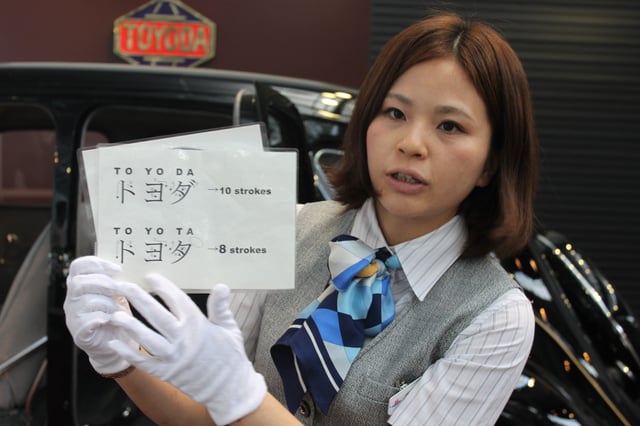
Employee at Toyota Museum explains development of Toyota name and brand

Toyota wordmark, used as a main logo until 1989 and is currently used as a corporate logo

Toyota Tacoma TRD Pro still uses Toyota wordmark
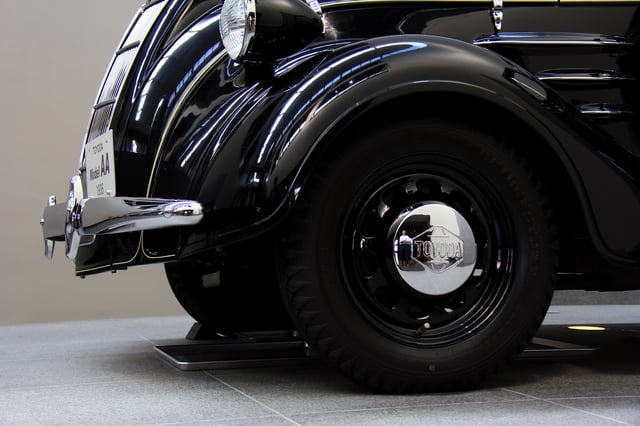
Hubcap of 1936 Toyota AA, with the old "Toyoda" name
In 1936, Toyota entered the passenger car market with its Model AA and held a competition to establish a new logo emphasizing speed for its new product line. After receiving 27,000 entries, one was selected that additionally resulted in a change of its moniker to "Toyota" from the family name "Toyoda". The new name was believed to sound better, and its eight-stroke count in the Japanese language was associated with wealth and good fortune. The original logo is no longer found on its vehicles but remains the corporate emblem used in Japan.
Still, no guidelines existed for the use of the brand name, so "TOYOTA", which was used throughout most of the world, led to inconsistencies in its worldwide marketing campaigns.
To remedy this, Toyota introduced a new worldwide logo in October 1989 to commemorate the 50th year of the company, and to differentiate it from the newly released luxury Lexus brand. The logo made its debut on the 1989 Toyota Celsior and quickly gained worldwide recognition. The three ovals in the new logo combine to form the letter "T", which stands for Toyota. The overlapping of the two perpendicular ovals inside the larger oval represents the mutually beneficial relationship and trust between the customer and the company while the larger oval surrounding both of these inner ovals represents the "global expansion of Toyota's technology and unlimited potential for the future".[54][55]
The new logo started appearing on all printed material, advertisements, dealer signage, and most of the vehicles themselves in 1990.
In countries or regions using traditional Chinese characters, e.g. Hong Kong and Taiwan, Toyota is known as "豐田".[56] In countries using simplified Chinese characters (e.g. China, Singapore), Toyota is written as "丰田"[57] (pronounced as Fēngtián in Mandarin Chinese and Hɔng Tshan in Minnanese). These are the same characters as the founding family's name "Toyoda" in Japanese.
Japan
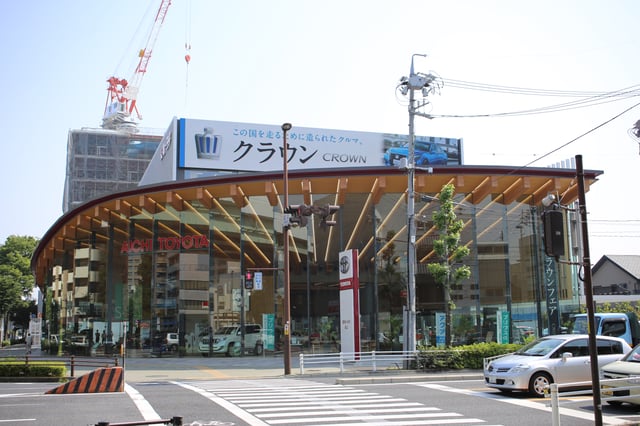
Toyota Store Aichi
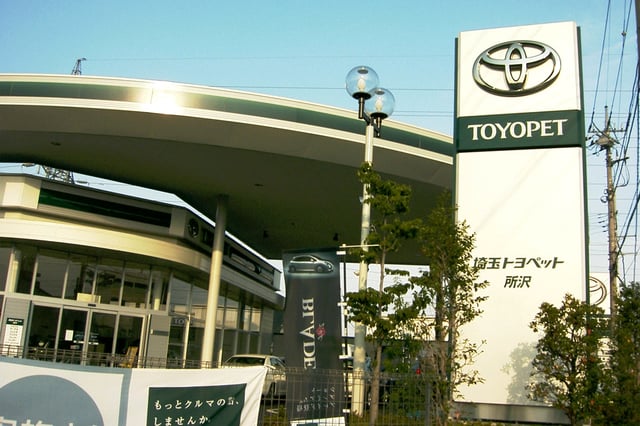
Toyopet Store, Saitama
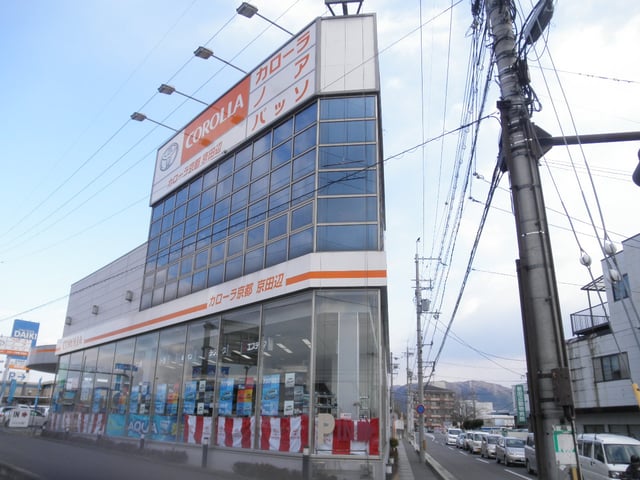
Corolla Store Kyotanabe

Netz Store, Tsurumi-ku, Osaka
In Japan, Toyota currently maintains separate dealership sales channels.[58] Toyota sought out to use a hierarchical marketing approach, similar to methods used in North America, but implemented it at all of its dealership chains, with some models being exclusive to particular locations.
The first sales channel established in 1946 is called "Toyota Store"[59] (トヨタ店 Toyota Mise) and offers large luxury sedans such as the Toyota Century and the Toyota Crown. In more recent years, the Toyota Store's line was expanded to include hybrid and alternate fuel vehicles. In 1955, the "Toyopet Store" (トヨペット店 Toyopetto-ten) arrived, originally established to sell the Toyota Corona and the Toyopet ToyoAce truck, and currently features mid-range models. (Toyota's five channel dealerships in Japan chronology in Japanese.)
The "Toyota Publica Store" (トヨタパブリカ店 Toyota Paburika-ten) was established in 1961 to sell the Toyota Publica. In 1966 it was renamed the "Toyota Corolla Store" (トヨタカローラ店 Toyota Karōra-ten) to sell the Toyota Corolla.[58] The dealership chain focuses on budget models.
The "Toyota Auto Store" (トヨタオート店 Toyota Ōto-ten) sales network was established in 1967 to sell the Corolla companion, the Toyota Sprinter, and was renamed "Netz Toyota Store" in 1998.[58] The "Vista" name was used on a new Camry-clone, called the Toyota Vista. The Toyota Vista network was replaced with two networks; "Netz Toyota" (ネッツトヨタ店 Nettsu-Toyota-ten) in August 1998, and Lexus in 2004. Some former Vista models were rebranded as Lexus (レクサス Rekusasu), such as the Altezza and the Aristo, while other products have been taken over by the "Netz Toyota", which was already selling the Toyota ist and the Toyota RAV4. "Netz" is an acronym for "Network of Energetic Teams for Zenith", and targets young buyers.
Toyota previously operated a commercial dealership called Toyota Diesel Shop (トヨタディーゼル店 Toyota Dīzeru-ten) from 1957 until 1988 that sold various commercial platform trucks, buses, and forklifts, such as the Toyota Dyna and the Toyota Coaster. Hino products were sold at specific Hino locations and shared at Toyota Diesel Store locations after Toyota acquired the company in 1967. Starting in 1980, the Diesel Shop also sold the Starlet, Corolla, Corona, Vista, and Crown installed with diesel engines. When the Toyota Diesel Store was disbanded, commercial products were divided between Toyota Store and Toyopet Store locations.
In 2012, selected Japanese dealership locations were given a special designation called "Area 86" that resembled the North American Toyota network, called Scion, to sell the Toyota 86, building on the marketing approach started with WiLL branded products.[58][60] As of 2017, the "Area 86" network was rebranded as "GR" for Gazoo Racing, sharing a similar approach to the performance division Toyota Racing Development or "TRD", providing various upgrades for the 86, Vitz, Prius, Mark X, Harrier, Noah and Voxy.[61]
In the female idol group, AKB48, Toyota and AKS, has worked together to create a subunit named 'Team 8'. Team 8 is created with the idea, 'Idols who come to meet you'. They have a total of 47 members, each representing a prefecture of Japan.
- Vehicles sold atToyota Store
The following is a list of all past and present models and where they were available at retail channels nationally. Most models were exclusive to particular retail chains, while some models, like the Prius, are available at all sales channels.[62] Retail chains in Tokyo, Osaka and Okinawa are different.[58]
[[INLINE_IMAGE|//upload.wikimedia.org/wikipedia/commons/a/ab/Toyota-Dealer-Toyota.png|undefined|Toyota-Dealer-Toyota.png|h29|w130]]
Century, Crown Majesta, Crown, Master, SAI, Mirai, Prius, Aqua, Allion, Succeed, Blade, Avensis, Sienta, Corolla RunX, C-HR, Porte, Estima, Isis, Roomy, FJ Cruiser, Comfort, Land Cruiser, Hilux Surf, Land Cruiser Prado, Dyna, Stout, Esquire, Coaster, QuickDelivery, 2000GT, Carina, Carina ED, GT-86, Brevis, Gaia, Cavalier, Classic, MasterAce, Hilux, Mega Cruiser, Soarer, Origin, Caldina.
- Vehicles sold atToyopet Store
[[INLINE_IMAGE|//upload.wikimedia.org/wikipedia/commons/4/4e/Toyota-Dealer-Toyopet.png|undefined|Toyota-Dealer-Toyopet.png|h29|w130]]
Mark X, SAI, Mirai, Premio, Prius, Aqua, Belta, Mark X ZiO, Succeed, Ractis, Auris, Blade, GT-86, Porte, Harrier, Vanguard, Esquire, Rush, C-HR, Avensis, Alphard, Comfort, HiAce, ToyoAce, Tank, Sienta, Pixis Space, Mark II-Mark II Qualis-Mark II Blit, Corona, Corona EXiV, Corona Coupe, Corsa, Opa, Avalon, Progrès, Cami, ist, Platz, Soarer, Hilux, Cynos, Regius, Celsior, Origin, Caldina, Ipsum.
- Vehicles sold atToyota Corolla Store(starting 1966), formerly Toyota Publica Store
[[INLINE_IMAGE|//upload.wikimedia.org/wikipedia/commons/2/21/Toyota-Dealer-Corolla.png|undefined|Toyota-Dealer-Corolla.png|h29|w130]]
SAI, Camry, Prius, Aqua, Corolla Axio, GT-86, Belta, Spade, Probox, Corolla Rumion, C-HR, Ractis, Passo, Corolla Verso, Sera, Vanguard, Roomy, Estima, Noah, Avensis, Sienta, TownAce, Pixis, Publica, Tercel, Windom, Scepter, Corolla Ceres, Origin, Nadia, WiLL, RAV4, Sports 800, Celica, Supra, Corolla Levin, Celica XX, Celica Camry.
- Vehicles sold atNetz Store(starting 1998), formerlyToyota Vista Store(starting 1980), formerly Toyota Auto Store (starting 1967)
[[INLINE_IMAGE|//upload.wikimedia.org/wikipedia/commons/2/2d/Toyota-Dealer-Netz.png|undefined|Toyota-Dealer-Netz.png|h34|w126]]
Vitz, SAI, Prius, Aqua, ist, Auris, bB, Avensis, Raum, Spade, Wish, Voxy, RAV4, C-HR, Kluger, Vellfire, iQ, Allex, Tank, Pixis, Fun Cargo, Pronard, Altezza, Verossa, Curren, Aristo, MR-S, MR2, Starlet, Vista, Cresta, Sprinter, Voltz, Blizzard, Chaser, Sprinter Marino, Carib, Granvia, Sprinter Trueno, LiteAce, Ipsum, GT-86, WiLL (1999–2004).
Toyota slogans
Australia
Oh What a feeling! (1983–present)[63]
Bangladesh
Running Towards (1974–1979)
Leads away your life (1979–1986)
The Greatest (1986–1991)
Interesting vehicle (1991–1998)
The Quality (1998–2005)
The Perfection of life (2005–2010)
The Amazing (2010–present)
Europe
India
Every-day (1997–2001)
Touch The Perfection (2001–2005)
Moving Forward (2005–2012)
Quality Revolution (2012–present)
Indonesia
Choice Of Trust (Indonesian: Terpilih Karena Terpercaya, 1984–1989)
Leads You Ahead (1989–2001)
Passion (2001–2004)
Because We Love You (2004–2006)
Moving Forward (2006–2015)
Let's Go Beyond (2015–present)[67]
Japan
ファミリーカーのトヨタ (Roma-ji:Famirika no Toyota, English:Toyota Family Car, 1966–1969)
進歩のマーク (Roma-ji:Shinpo no Maku, English:Mark of Progress, 1967–1970)
愛される車をめざして (Roma-ji:Aisareru-sha no Mezashite, English:Toward the car be loved, 1971–1980)
安全はトヨタの願い (Roma-ji:Anzen wa Toyota no Negai, English:Safety Wish of Toyota, 1978–1982)
新技術-時代はToyota (Roma-ji:Shingijutsu jidai wa TOYOTA, English:The New Era of Toyota Technology, 1982–1988)
Fun To Drive (1984–1990)
新しいトヨタが走りはじめます。 (Roma-ji:Atarashi Toyota ga Hashiri Hajimemasu, English:The New Toyota Will Begin Running, 1989–1990)
人へ。社会へ。地球へ。 (Roma-ji:Hito e, Shakai e, Chikyuu e, English:For People, For Society, For The Earth, 1990–1999)
Big Challenge (1993–1996)
Sedan Innovation (1993–1998)
Action Toyota (1997–1998)
クルマが未来になっていく。 (Roma-ji:Kuruma ga Mirai ni Natte iku, English:The car is Gradually Turned to The Future, 1998–1999)
Drive Your Dreams. (2000–2013)
Fun to Drive, Again. (2013–2017)
Toyota Next One (2014–2015)
The World is One (2015–2017)
Start Your Impossible (2017–present)
Malaysia
Leads You Ahead (1989–2001)
Passion (2001–2005)
Get The Feeling (2001–2005)
Moving Forward (2005–2016)
All About The Drive (2016–present)[68]
Philippines
You Asked For It You Got It (Mid 70s-Early 80s) (Delta Motors Corp)
Leads You Ahead/The Will To Serve (1989–1995)
I Love This Car (1996-1999)
Passion (2001–2005)
Moving Forward (2005–present)
Singapore
I Love what you do for me (1989–1997)
Everyday (1997–2001)
Get The Feeling (2001–2005)
Moving Forward (2005–2012)
Always Better (2012–present)
South Africa
Everything keeps going right, Toyota (1973–2004)
Lead The Way (2004–present)
South Korea
Smile For Tomorrow (2009-2014)
You Are So Smart (2014-2019)
Enjoy Your Style (2019–Present)
Thailand
เร้าใจทุกเส้นทาง -ยุคหน้า โตโยต้า ("Exciting All Directions - Next Generation Toyota", 1988–1992)
สัมผัสแห่งคุณภาพ ("Quality Touch", 1992–1994)
It's My Style (1995–1998)
Leads You Ahead (1989–2001)
Passion (2001–2003)
Yes We Drive (2003–2005)[69]
Moving Forward (2005–2012)
ขับเคลื่อนความสุข ("Mobility of Happiness", 2012–present)
Live Alive (2018–present)
United States
You asked for it, You got it! (1975–1979)[70]
Oh What a feeling! (1979–1985)[70]
Who could ask for anything more? (1985–1989)
I love what you do for me (1989–1997) Spanish: Estas hecho para mi
Everyday (1997–2001)
Get The Feeling (2001–2004)
Moving Forward (2004–2012) Spanish: Avanza Confiado[71]
Let's Go Places (2012–present) Spanish: Vayamos Juntos (Let's go together)
Vietnam
Tiến tới tương lai ("Moving Forward", 2006–2016)
Chuyển động tiên phong ("Leading Mobility", 2016–present)
Sports
Toyota sponsors several teams and has purchased naming rights for several venues, including:
Toyota Center, Houston, Texas
Toyota Center, Kennewick, Washington
Toyota Field, San Antonio, Texas
Toyota Park, Bridgeview, Illinois
Toyota Sports Center, El Segundo, California
Toyota Stadium, Georgetown, Kentucky
Toyota Stadium, Frisco, Texas
As of 2017, Toyota is an official sponsor of Cricket Australia,[72] the England and Wales Cricket Board[73] and the AFL.[74] In March 2015, Toyota became a sponsor partner for the Olympic Games, in the form of supplying vehicles and communications between vehicles until 2024.[75]
Company strategy
Toyota's management philosophy has evolved from the company's origins and has been reflected in the terms "Lean Manufacturing" and Just In Time Production, which it was instrumental in developing.[76] Toyota's managerial values and business methods are known collectively as the Toyota Way. Many businesses worldwide have adopted a similar approach to manufacturing.
In April 2001, Toyota adopted the "Toyota Way 2001", an expression of values and conduct guidelines that all Toyota employees should embrace. Under the two headings of Respect for People and Continuous Improvement, Toyota summarizes its values and conduct guidelines with these five principles:[77]
Challenge
Kaizen (improvement)
Genchi genbutsu (go and see)
Respect
Teamwork
According to external observers, the Toyota Way has four components:[78]
Long-term thinking as a basis for management decisions
A process for problem-solving
Adding value to the organization by developing its people
Recognizing that continuously solving root problems drives organizational learning
The Toyota Way incorporates the Toyota Production System.
Operations

New Toyota factory in Ohira, near Sendai, Miyagi Prefecture, Japan: A month after this picture was taken, the region was devastated by the March 11 earthquake and tsunami. The plant was only lightly damaged, but remained closed more than a month, mainly due to lack of supplies and energy, in addition to a badly damaged Sendai port.
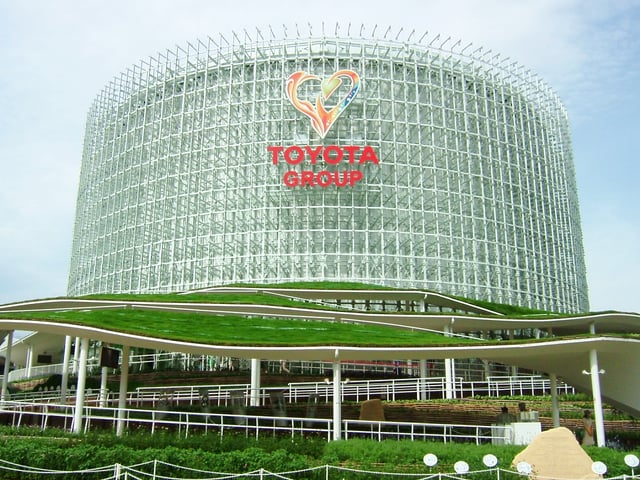
Toyota Pavilion at the Expo in Aichi
Toyota has long been recognized as an industry leader in manufacturing and production. Three stories of its origin have been found, one that they studied Piggly-Wiggly's just-in-time distribution system,[79] one that they followed the writings of W. Edwards Deming,[80] and one that they were given the principles from a WWII US government training program (Training Within Industry).[81]
As described by external observers of Toyota, the principles of the Toyota Way are:[78]
Base your management decisions on a long-term philosophy, even at the expense of short-term goals
Create continuous process flow to bring problems to the surface
Use "pull" systems to avoid overproduction
Level out the workload
Build a culture of stopping to fix problems, to get quality right the first time
Standardized tasks are the foundation for continuous improvement and employee empowerment
Use visual control so no problems are hidden
Use only reliable, thoroughly tested technology that serves your people and processes
Grow leaders who thoroughly understand the work, live the philosophy, and teach it to others
Develop exceptional people and teams who follow your company's philosophy
Respect your extended network of partners and suppliers by challenging them and helping them improve
Go and see for yourself to thoroughly understand the situation (genchi genbutsu)
Make decisions slowly by consensus, thoroughly considering all options; implement decisions rapidly
Become a learning organization through relentless reflection and continuous improvement (kaizen)
Toyota has grown from its origins in Japan during the 1930s to become a large multinational corporation. It displaced GM and became the world's largest automobile maker for the year 2008. It held the title of the most profitable automobile maker (US$11 billion in 2006) along with increasing sales in, among other countries, the United States. The world headquarters of Toyota are located in its home country in Toyota City, Japan. Its subsidiary, Toyota Financial Services sells financing and participates in other lines of business. Toyota brands include Scion and Lexus and the corporation is part of the Toyota Group. Toyota also owns 51% of Daihatsu, and 16.7% of Fuji Heavy Industries, which manufactures Subaru vehicles. They also acquired 5.9% of Isuzu Motors Ltd. on November 7, 2006, and will be introducing Isuzu diesel technology into their products.
Toyota has introduced new technologies, including one of the first mass-produced hybrid gasoline-electric vehicles, the Prius, of which it has sold 2 million globally as of 2010,[82] Advanced Parking Guidance System (automatic parking), a four-speed electronically controlled automatic with buttons for power and economy shifting, and an eight-speed automatic transmission. Toyota, and Toyota-produced Lexus and Scion automobiles, consistently rank near the top in certain quality and reliability surveys, primarily J.D. Power and Consumer Reports[83] although they led in automobile recalls for the first time in 2009.[84]
In 2005, Toyota, combined with its half-owned subsidiary Daihatsu Motor Company, produced 8.54 million vehicles, about 500,000 fewer than the number produced by GM that year. Toyota has a large market share in the United States, but a small market share in Europe. It also sells vehicles in Africa and is a market leader in Australia. Due to its Daihatsu subsidiary, it has significant market shares in several fast-growing Southeast Asian countries.[85]
According to the 2017 Fortune Global 500, Toyota is the fifth largest company in the world. Since the recession of 2001, it has gained market share in the United States. Toyota's market share struggles in Europe where its Lexus brand has 0.3% market share, compared to nearly 2% market share as the US luxury segment leader.
In the first three months of 2007, Toyota together with its half-owned subsidiary Daihatsu reported number one sales of 2.348 million units. Toyota's brand sales had risen 9.2% largely on demand for Corolla and Camry sedans. The difference in performance was largely attributed to surging demand for fuel-efficient vehicles. In November 2006, Toyota Motor Manufacturing Texas added a facility in San Antonio.[86] Toyota has experienced quality problems and was reprimanded by the government in Japan for its recall practices.[87] In 2007, Toyota maintained over 16% of the US market share and was listed second only to GM in terms of volume.[88] Toyota Century Royal is the official state car of the Japanese imperial family, namely for the current Emperor of Japan.
Toyota was hit by the global financial crisis of 2008 as it was forced in December 2008 to forecast its first annual loss in 70 years.[89] In January 2009, it announced the closure of all of its Japanese plants for 11 days to reduce output and stocks of unsold vehicles.[90]
Akio Toyoda became the new president and CEO of the company on June 23, 2009, by replacing Katsuaki Watanabe, who became the new vice chairman by replacing Katsuhiro Nakagawa.[91]
Technology
In 2018 Toyota was regarded as being behind in smart car technology and in need of innovation.[92] The company invested $4 billion in a robotics and AI research institute to create safer vehicles.[92] Alongside the robotics and AI centre, Toyota launched a $2.8 Billion dollar Self-Driving Car Company called Toyota Research Institute-Advanced Development, or TRI-AD,[93] with automotive supplier Aisin Seiki and Denso.[94]
Toyota invested $500m in the driverless car company Uber[95] with the ambition to build the combined technology into Toyota's Sienna minivans, to be used on Uber's ride-hailing network from 2021.[96] In 2019 Toyota partnered with Chinese technology firm Cogobuy to build a Smart Car Ecosystem in the hopes of turning the company from manufacturing-oriented to intelligence-oriented.[97]
In early 2019 it was announced that Japan is planning a moon landing for 2029 and wants its astronauts to explore the lunar surface in a vehicle built by Japanese automaker Toyota.[98]
Worldwide presence
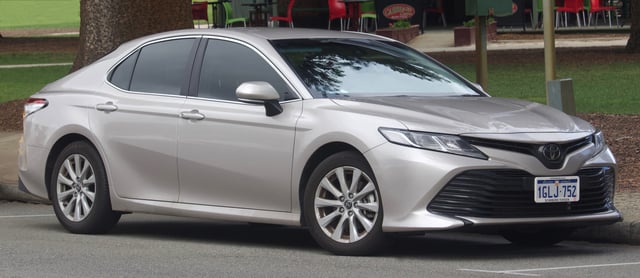
The Toyota Camry is assembled in several facilities around the world including Australia, China, Taiwan, Japan, Indonesia, Malaysia, the Philippines, Russia, Thailand, India, Vietnam, and the United States
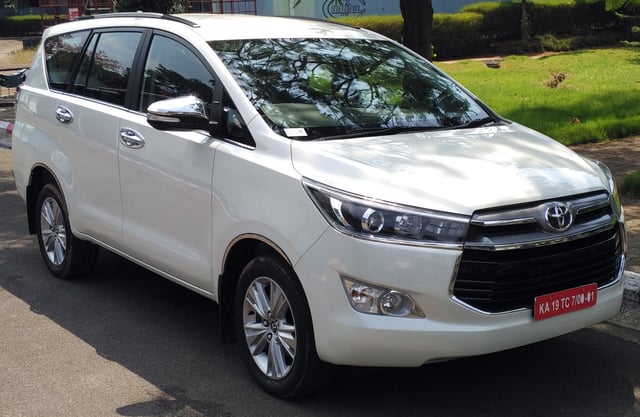
The Toyota Innova is one of the vehicles designed as part of the IIMV project.
Toyota has factories in most parts of the world, manufacturing or assembling vehicles for local markets in Japan, Australia (until 2017), Bangladesh, India, Sri Lanka, Canada, Indonesia, Poland, South Africa, Turkey, Colombia, the United Kingdom, the United States, France, Brazil, Portugal, and more recently, Argentina, Czech Republic, Mexico (Tijuana), Malaysia, Thailand, Pakistan, Egypt, China, Vietnam, Venezuela, the Philippines, and Russia.
Toyota's net revenue by geographical regions for the year ended March 31, 2007:[99]
| Geographic region | Total sales ( Yen in millions) |
| Japan | 8,152,884 |
| North America | 8,771,495 |
| Europe | 3,346,013 |
| Asia | 1,969,957 |
| Others | 1,707,742 |
In 2002, Toyota initiated the Innovative International Multi-purpose Vehicle project (IIMV) to optimize global manufacturing and supply systems for pickup trucks and multipurpose vehicles, and to satisfy market demand in more than 140 countries worldwide. IIMV called for diesel engines to be made in Thailand, gasoline engines in Indonesia, and manual transmissions in India and the Philippines, for supply to the countries charged with vehicle production. For vehicle assembly, Toyota would use plants in Thailand, Indonesia, Argentina, and South Africa. These four main IIMV production and export bases supply Asia, Europe, Africa, Oceania, Latin America, and the Middle East with three vehicles: The Toyota Hilux (Vigo), the Fortuner, and the Toyota Innova.[100]
North America
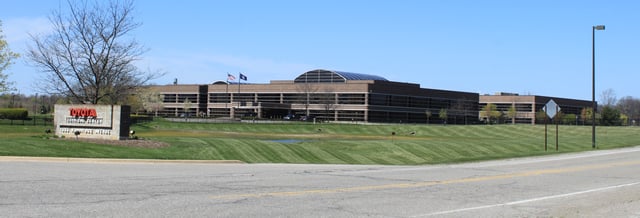
Toyota Technical Center, Ann Arbor Charter Township, Michigan
Toyota Motor North America headquarters is located in Plano, Texas, and operates as a holding company in North America. Its production engineering and manufacturing headquarters is located in Georgetown, Kentucky.
Toyota Canada Inc. has been in production in Canada since 1983 with an aluminium wheel plant in Delta, British Columbia, which currently employs a workforce of roughly 260. Its first vehicle assembly plant, in Cambridge, Ontario, since 1988, now produces Corolla compact cars, Matrix crossover vehicles, and Lexus RX 350 luxury SUVs, with a workforce of 4,300 workers. Its second assembly operation in Woodstock, Ontario, began manufacturing the RAV4 late in 2008.[101] In 2006, Toyota's subsidiary Hino Motors opened a heavy duty truck plant, also in Woodstock, employing 45 people and producing 2000 trucks annually.[102]
Toyota has a large presence in the United States with six major assembly plants in Huntsville, Alabama, Georgetown, Kentucky, Princeton, Indiana, San Antonio, Texas, Buffalo, West Virginia, and Blue Springs, Mississippi. Toyota had a joint-venture operation with General Motors at New United Motor Manufacturing Inc. in Fremont, California, which began in 1984 and ended in 2009.[103] It still has a joint venture with Subaru at Subaru of Indiana Automotive, Inc. in Lafayette, Indiana, which started in 2006. In these assembly plants, the Camry and the Tundra are manufactured, among others.
Toyota marketing, sales, and distribution in the US are conducted through a separate subsidiary, Toyota Motor Sales, U.S.A., Inc. It has started producing larger trucks, such as the new Tundra, to go after the large truck market in the United States. Toyota is also pushing hybrid vehicles in the US such as the Prius, Camry Hybrid, Highlander Hybrid, and various Lexus products. Currently, Toyota has no plans to offer diesel motor options in its North American products, including the light-duty pickup trucks.[104]
Europe
Australia
In 1963, Australia was one of the first countries to assemble Toyotas outside Japan. However, in February 2014, Toyota was the last of Australia's major automakers to announce the end of production in Australia. The closure of Toyota's Australian plant was completed on October 3, 2017, and had produced a total 3,451,155 vehicles. At its peak in October 2007, Toyota manufactured 15,000 cars a month.[105] Before Toyota, Ford and GM's Holden had announced similar moves, all citing an unfavorable currency and attendant high manufacturing costs.[106]
Product line
Electric technology
Hybrid electric vehicles

The Toyota Prius, flagship of Toyota's hybrid technology, is the world's best-selling hybrid car with almost 4 million units sold as of January 2017.[10]

The Toyota Prius c is the second spin-off of the Prius family, and the second most sold TMC hybrid after the Prius liftback, with almost 1.38 million units sold as of January 2017.[10]
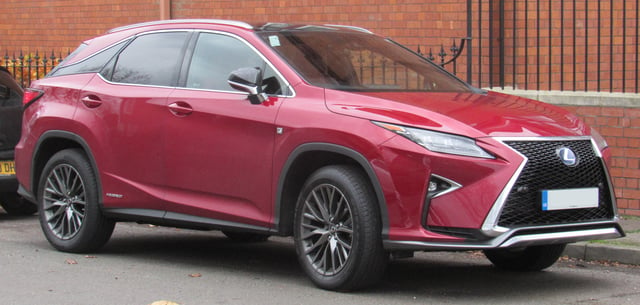
The Lexus RX 450h is the top selling hybrid of the Lexus brand with global sales of 363,000 units as of January 2017.[10]
Toyota is the world's market leader in sales of hybrid electric vehicles, one of the largest companies to encourage the mass-market adoption of hybrid vehicles across the globe, and the first to commercially mass-produce and sell such vehicles, with the introduction of the Toyota Prius in 1997.[107][108] The company eventually began providing this option on its main passenger cars such as Camry and later with the Lexus divisions, producing some hybrid luxury vehicles. It labeled such technology in Toyota cars as "Hybrid Synergy Drive" and in Lexus versions as "Lexus Hybrid Drive". Cumulative global sales of Toyota and Lexus hybrid passenger car models passed the 10 million milestone in January 2017.[10] Its Prius family is the world's top-selling hybrid nameplate with almost 4 million units sold worldwide as of January 2017.[10]
As of January 2017, Toyota Motor Corporation sells 33 Toyota and Lexus hybrid passenger car models and one plug-in hybrid in over 90 countries and regions around the world, and the carmaker expects to achieve annual sales of 1.5 million units, and cumulative sales of 15 million units by 2020.[10] The Prius liftback is the world's top selling hybrid gasoline-electric car, its sales achieved the 3 million unit milestone in June 2013,[109] and cumulative sales since 1997 totaled 3,984,600 units at the end of January 2017.[10] The Prius liftback ranks as the top selling hybrid car in the U.S. market, and passed the 1 million milestone in April 2011.[110] Cumulative sales of the Prius in Japan reached the 1 million mark in August 2011.[111] As of January 2017, sales of the Prius liftback totaled over 1.8 million units in Japan and 1.75 million in the United States.[10] Cumulative TMC hybrid sales since the Prius introduction in Europe in 2000 passed the 1 million unit milestone in November 2015.[112]
Worldwide sales of hybrid vehicles produced by Toyota reached 1 million vehicles by May 31, 2007, and the 2 million mark was reached by August 2009, with hybrids sold in 50 countries.[113][114] The 5 million hybrid sales milestone was reached in March 2013.[115] During 2012, Toyota and Lexus hybrid models sold more than 1 million units a year for the first time, with 1.219 million units sold.[116] During 2013, TMC sold 1.279 million units, and the 6 million sales milestone was achieved in December 2013, just nine months after its latest million unit milestone.[117] The 7 million sales mark was reached in September 2014, again, selling one million hybrids in nine months,[118] and the 8 million sales milestone was achieved in July 2015, just 10 months after the previous million-unit milestone.[119] The 9 million sales mark was reached in April 2016, again, selling one million hybrids in just nine months,[107] and the 10 million milestone in January 2017, one more time nine months later.[10] Toyota estimates that up to January 31, 2017, its hybrids have saved about 7.66 billion U.S. gallons of gasoline (29 billion liters) compared to the amount used by gasoline-powered vehicles of similar size, and have emitted approximately 77 million fewer tons of carbon dioxide (CO2) emissions than would have been emitted by gasoline-powered vehicles of similar size and driving performance.[10]
As of April 2016, besides the four Prius liftback generations, Toyota's hybrid lineup includes the Prius α/Prius v/Prius +, Aqua/Prius c, Camry Hybrid (1st and 2nd generation), Toyota Highlander Hybrid (Kluger Hybrid in Japan), Toyota Avalon Hybrid, Toyota Auris Hybrid, Toyota Yaris Hybrid (Europe only), and the following models sold only in Japan: Alphard Hybrid/Vellfire Hybrid, Estima Hybrid, Toyota Sai, Toyota Harrier, Toyota Crown Hybrid, Toyota Crown Mild Hybrid, Toyota Crown Majesta, Corolla Axio, Corolla Fielder, Toyota Voxy/Noah/Esquire, Toyota Sienta, Toyota Corolla Hybrid, Toyota Levin Hybrid, and Toyota RAV4 Hybrid.[107]
Beginning in 2011, TMC introduced three new members to the Prius family, the Prius v (Prius α in Japan and Prius + in Europe), the Prius c (Toyota Aqua in Japan), and the Toyota Prius Plug-in Hybrid, released in 2012 in Japan, the U.S., and Europe.[120] With a total of 247,230 vehicles sold during the first quarter of 2012, the Toyota Prius family became the third top selling nameplate in the world in terms of total global sales after the Toyota Corolla (300,800 units) and the Ford Focus (277,000 units).[121][122] Until September 2012, the Prius liftback was the top selling new car in Japan for 16 months in a row, until it was surpassed by the Toyota Aqua (Prius c) in October 2012.[123][124] With 266,567 units sold in Japan in 2012, the Aqua is considered the most successful nameplate launch in the Japanese market in the last 20 years.[125]
The Prius c/Aqua model, with global sales of 1,380,100 units through January 2017, is TMC's second best-selling hybrid after the Prius liftback, followed the Prius α/v/+ with 671,200 units, and the two generations of the Camry Hybrid, with 614,700 units sold worldwide, all through January 2017.[10] For both Prius family variants, Japan is the top selling market while the U.S. is the top-selling Camry market.[10] Ranking next is the Auris with 378,000 units sold, with Europe as the top market with 354,600 units sold.[10]
Lexus also has their own hybrid lineup, and as of August 2015, consist of the LS 600h/LS 600h L, GS 450h, RX 400h/RX 450h, Lexus HS 250h, Lexus CT 200h, Lexus ES 300h, Lexus IS 300h, Lexus NX 300h, and Lexus RC 300h.[119] Global cumulative sales of Lexus brand hybrids reached the 500 thousand mark in November 2012.[115] The 1 million sales milestone was achieved in March 2016.[126] The Lexus RX 400h/RX 450h ranks as the top selling Lexus hybrid with 363,000 units delivered worldwide as of January 2017, followed by the Lexus CT 200h with 290,800 units, and the Lexus ES 300h with 143,200 units.[10]
Plug-in hybrids
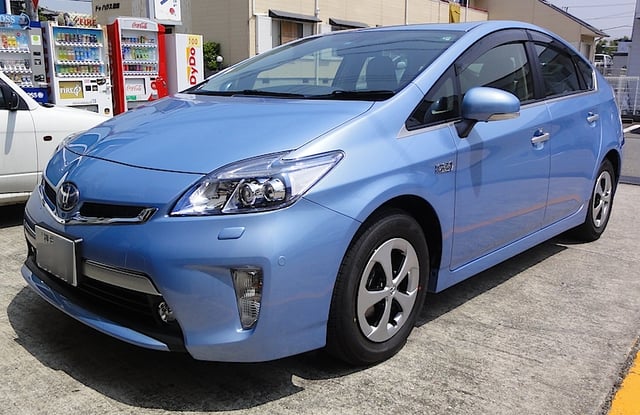
First generation Toyota Prius Plug-in Hybrid
Toyota's plug-in hybrid electric vehicle project began in 2007, with road trials of the prototype vehicle in France and the UK in 2008. Toyota made 600 Prius plug-in demonstration vehicles for lease to fleet and government customers. 230 were delivered in Japan beginning in late December 2009, 125 models released in the U.S. by early 2010, and 200 units in 18 European countries in 2010. France, the UK, and Germany had the largest fleets with 150 PHEVs.[127][128][129] Canada, China, Australia, and New Zealand also participated in the global demonstration program.[128][130][131]
The production version of the Toyota Prius Plug-in Hybrid was released in Japan in January 2012,[132][133] followed by the United States in late February,[134] and deliveries in Europe began in late June 2012.[135] As of April 2016, global sales totaled 75,400 Prius PHVs since 2012, with North America as the leading regional market with 42,700 units, followed by Japan with about 22,100 units, Europe with 10,500 units, and only about 100 units in the rest of the world.[107] The United States is the country market leader with 42,320 units delivered through April 2016.[136][137] The leading European market is the Netherlands with 4,134 units registered as of 30 November 2015.[138]
During its first year in the market, a total of 27,279 Prius PHVs were sold worldwide,[139] allowing the plug-in version to rank as the second most sold plug-in electric car for 2012.[140] Accounting for cumulative sales since its inception, the Prius PHV was the world's all-time third best selling plug-in electric car by December 2014.[141] Production of the first generation Prius Plug-in ended in June 2015.[142] As of May 2015, the Prius Plug-in Hybrid ranked as the world's second top selling plug-in hybrid ever after the Volt/Ampera family.[143] As of April 2016, the Prius plug-in ranking among the top selling plug-in cars fell to fifth place after the Tesla Model S and the Mitsubishi Outlander P-HEV.[144]
The second generation Prius plug-in hybrid, named Toyota Prius Prime in the US, was unveiled at the 2016 New York International Auto Show, and was released in the U.S. in November 2016. Unlike the first generation model, it is available in all 50 states.[145][146] Sales in Japan started on February 15, 2017.
All-electric vehicles
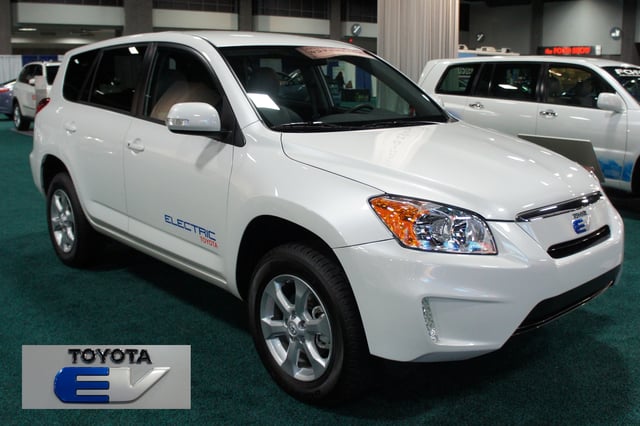
Second generation Toyota RAV4 EV
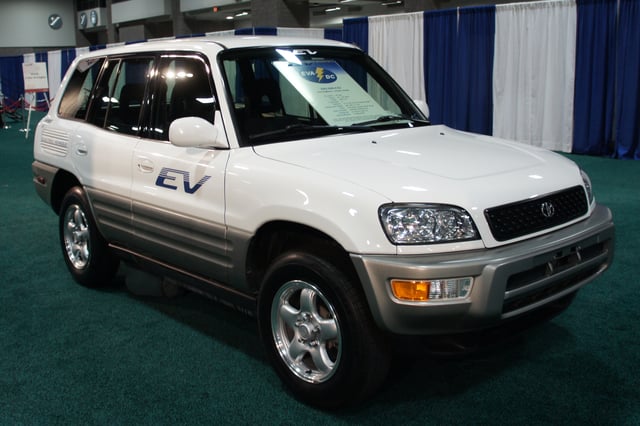
First generation Toyota RAV4 EV
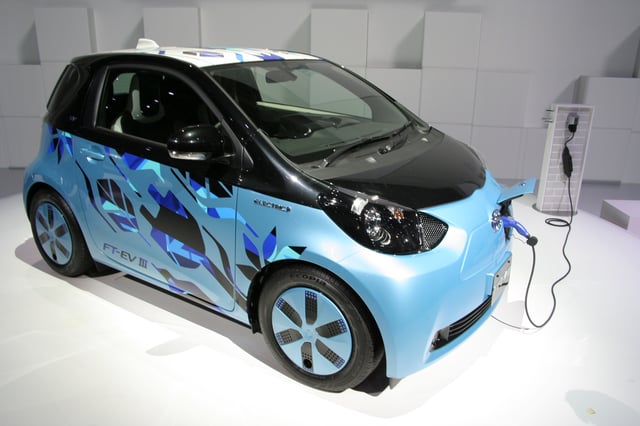
The Toyota iQ/Scion iQ EV is based on Toyota's three generations of FT-EV concept. Shown the Toyota FT-EV III concept car at the 2011 Tokyo Motor Show.
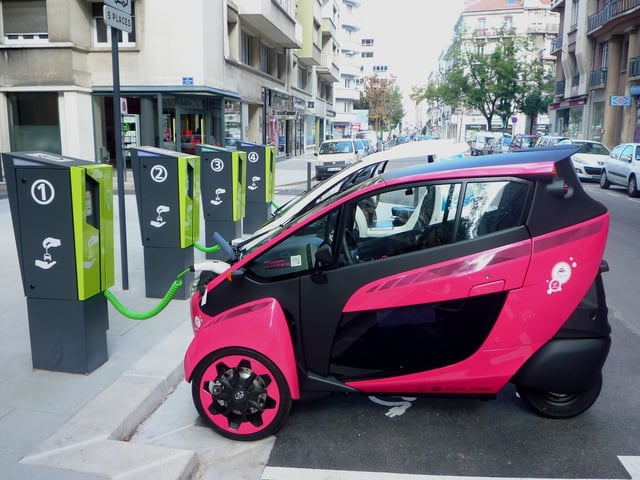
Toyota I-Road in Grenoble
The first generation Toyota RAV4 EV was leased in the United States from 1997 to 2003, and at the lessees' request, many units were sold after the vehicle was discontinued.[147] A total of 1,484 were leased and/or sold in California to meet the state's CARB mandate for zero-emissions vehicles.[148][149] As of mid-2012, there were almost 500 units still in use.[150]
In May 2010, Toyota launched a collaboration with Tesla Motors to create electric vehicles. Toyota agreed to purchase US$50 million of Tesla common stock subsequent to the closing of Tesla's planned initial public offering.[151] Toyota, with the assistance of Tesla, built 35 converted RAV4s (Phase Zero vehicles) for a demonstration and evaluation program that ran through 2011. The lithium metal-oxide battery and other power train components were supplied by Tesla Motors.[152][153] Four years later, Toyota, along with Daimler, began to unwind its position in Tesla.[154] Toyota and Daimler made more than $1 bln from the investment.[155]
The Toyota RAV4 EV Concept was released in September 2012.[156] The RAV4 EV was assembled at Toyota's facility in Woodstock, Ontario along with the regular gasoline version. Tesla built the electric powertrain at its plant at Tesla Factory in Fremont, California, and then shipped them to Canada.[157][158] The RAV4 EV was sold only in California, beginning with the San Francisco Bay Area, Los Angeles/Orange County, and San Diego. Production was limited to 2,600 units during a three-year period.[159][160] As of 31 December 2015, a total of 2,340 RAV4 EVs were sold in the U.S. to retail customers.[161][162][163] Production ended in September 2014.[164]
A prototype of the Toyota iQ EV (Scion iQ EV in the US) was exhibited at the 2011 Geneva Motor Show. The Scion iQ EV is the successor to the FT-EV II as an electric vehicle based on the Toyota iQ chassis.[165][166] Toyota produced three generations of FT-EV concept cars, and the iQ EV is a production version of those concepts, incorporating the technological and design strengths of all three models. The exterior of the production version is based on the FT-EV III concept shown at the 2011 Tokyo Motor Show.[167]
The U.S. launch of the Scion iQ EV was announced for 2012,[168][169] and according to Toyota, for the initial roll-out the iQ EV would not be available to individual consumers, instead, the carmaker decided to focus on fleet customers and car sharing programs.[170] The iQ EV was scheduled to be produced at Toyota's Takaoka Plant in Toyota City beginning in August 2012 and the initial production was planned to be limited to 600 units, with 400 staying in Japan, 100 units destined to the U.S., and the other 100 for Europe.[171] In September 2012, Toyota announced that due to customers' concerns about range and charging time, the production of the Scion iQ (Toyota eQ in Japan) will be limited to about 100 units for special fleet use in Japan and the U.S. only. The iQ EV/eQ was scheduled to be released in both countries in December 2012.[172]
The first 30 iQ EVs were delivered in the U.S. to the University of California, Irvine in March 2013 for use in its Zero Emission Vehicle-Network Enabled Transport (ZEV-NET) carsharing fleet. Since 2002, the ZEV-NET program has been serving the transport needs of the Irvine community with all-electric vehicles for the critical last mile of commutes from the Irvine train station to the UC campus and local business offices.[173]
In addition, Toyota announced that is backing away from fully electric vehicles. The company's vice chairman, Takeshi Uchiyamada, said: "The current capabilities of electric vehicles do not meet society’s needs, whether it may be the distance the cars can run, or the costs, or how it takes a long time to charge." Toyota's emphasis would be re-focused on the hybrid concept, and 21 new hybrid gas-electric models scheduled to be on the market by 2015.[172][174]
Hydrogen fuel-cell
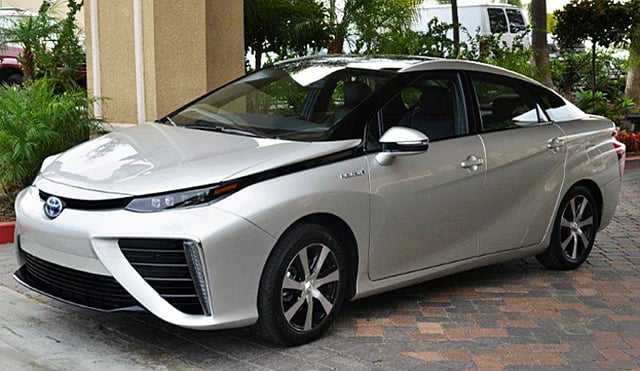
The Toyota Mirai fuel-cell vehicle
In 2002, Toyota began a development and demonstration program to test the Toyota FCHV, a hybrid hydrogen fuel cell vehicle based on the Toyota Highlander production SUV. Toyota also built a FCHV bus based on the Hino Blue Ribbon City low-floor bus.[178][179] Toyota has built several prototypes/concepts of the FCHV since 1997, including the Toyota FCHV-1, FCHV-2, FCHV-3, FCHV-4, and Toyota FCHV-adv. The Toyota FCV-R fuel cell concept car was unveiled at the 2011 Tokyo Motor Show. The FCV-R sedan seats four and has a fuel cell stack including a 70 MPa high-pressure hydrogen tank, which can deliver a range of 435 mi (700 km) under the Japanese JC08 test cycle. Toyota said the car was planned for launch in about 2015.[180]
In August 2012, Toyota announced its plans to start retail sales of a hydrogen fuel-cell sedan in California in 2015. Toyota expects to become a leader in this technology.[181] The prototype of its first hydrogen fuel cell vehicle will be exhibited at the November 2013 Tokyo Motor Show, and in the United States at the January 2014 Consumer Electronics Show.[182]
Toyota's first hydrogen fuel-cell vehicles to be sold commercially, the Toyota Mirai (Japanese for "future"), was unveiled at the November 2014 Los Angeles Auto Show.[183] In January 2015, it was announced that production of the Mirai fuel cell vehicle would increase from 700 units in 2015 to approximately 2,000 in 2016 and 3,000 in 2017.[184] Sales in Japan began on December 15, 2014, at a price of ¥6,700,000 (~US$57,400). The Japanese government plans to support the commercialization of fuel-cell vehicles with a subsidy of ¥2,000,000 (~US$19,600).[185] Retail sales in the U.S. began in August 2015 at a price of US$57,500 before any government incentives. Initially, the Mirai will only be available in California.[186][187] The market release in Europe is slated for September 2015, and initially will be available only in the UK, Germany, and Denmark, followed by other countries in 2017. Pricing in Germany starts at €60,000 (~US$75,140) plus VAT (€78,540).[188]
Cars
As of 2009, Toyota officially lists approximately 70 different models sold under its namesake brand, including sedans, coupes, vans, trucks, hybrids, and crossovers.[193] Many of these models are produced as passenger sedans, which range from the subcompact Toyota Yaris, compact Corolla, to mid-size Camry and full-size Avalon.[193] Vans include the Previa/Estima, Sienna, and others.[193] Several small cars, such as the xB and tC, were sold under the Scion brand.[193]
SUVs and crossovers
Pickup trucks
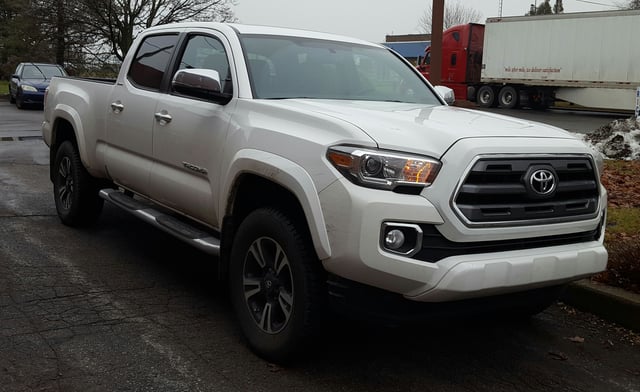
Toyota Tacoma, one of the best selling vehicles in the United States of America

Toyota Hilux
Toyota first entered the pickup truck market in 1947 with the SB that was only sold in Japan and limited Asian markets. It was followed in 1954 by the RK (renamed in 1959 as the Stout) and in 1968 by the compact Hilux. With continued refinement, the Hilux (simply known as the Pickup in some markets) became famous for being extremely durable and reliable, and many of these trucks from as early as the late 1970s are still on the road today, some with over 300,000 miles. Extended- and crew-cab versions of these small haulers were eventually added, and Toyota continues to produce them today under various names depending on the market.
Riding on the success of the compact pickups in the US, Toyota decided to attempt to enter the traditionally domestic-dominated full-size pickup market, introducing the T100 for the 1993 US model year, with production ending in 1998. While having a bed at the traditional full-size length of 8 feet, the suspension and engine characteristics were still similar to that of a compact pickup. It proved to be as economical and reliable as any typical Toyota pickup, but sales never became what Toyota brass had hoped for. It was criticized as being too small to appeal to the traditional American full-size pickup buyer. Another popular full-size truck essential, a V8 engine, was never available. Additionally, the truck was at first only available as a regular cab, though Toyota addressed this shortcoming and added the Xtracab version in mid-1995.
In 1999 for the 2000 model year, Toyota replaced the T100 with the larger Tundra. The Tundra addressed criticisms that the T100 did not have the look and feel of a legitimate American-style full-size pickup. It also added the V8 engine that the T100 was criticized for not having. However, the Tundra still came up short in towing capacity as well as still feeling slightly carlike. These concerns were addressed with an even larger 2007 redesign. A stronger V6 and a second V8 engine among other things were added to the option list. As of early 2010, the Tundra has captured 16% of the full-size half-ton market in the US. The all-new Tundra was assembled in San Antonio, Texas, US. Toyota assembled around 150,000 Standard and Double Cabs, and only 70,000 Crew Max's in 2007. The smaller Tacoma (which traces its roots back to the original Hilux) was also produced at the company's San Antonio facility.
Outside the United States, Toyota produced the Hilux in Standard and Double Cab, gasoline and diesel engine, and 2WD and 4WD versions. The BBC's Top Gear TV show featured two episodes of a Hilux that was deemed "virtually indestructible".[194]
Luxury-type vehicles
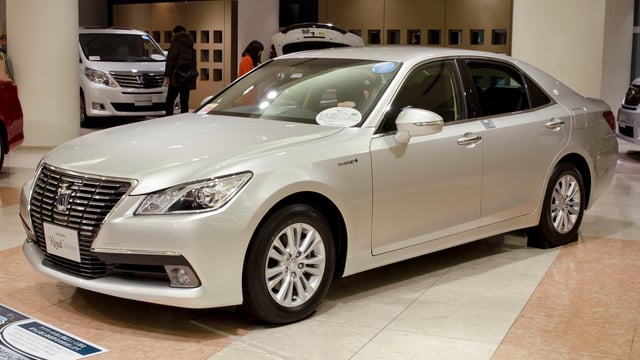
Toyota Crown Royal
As of 2009, the company sold nine luxury-branded models under its Lexus division, ranging from the LS sedan to RX crossover and LX SUV.[193] Luxury-type sedans produced under the Toyota brand included the Century, Crown, and Crown Majesta.[193] A limited-edition model produced for the Emperor of Japan was the Century Royal. Toyota-branded luxury vehicles tend to be Japan-only.
Buses
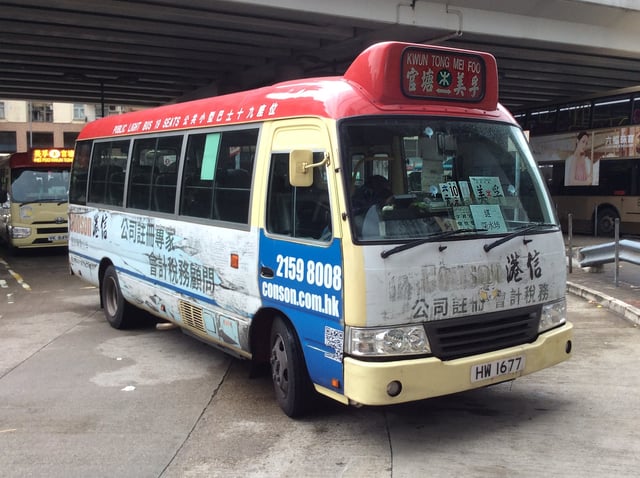
Toyota Coaster bus
Toyota Coaster minibus Hino Liesse II
Hino Liesse minibus
Pleasure boats
In 1997, building on a previous partnership with Yamaha Marine, Toyota created "Toyota Marine",[195] building private ownership motorboats, currently sold only in Japan. A small network in Japan sells the luxury craft at 54 locations, called the "Toyota Ponam" series, and in 2017, a boat was labeled under the Lexus brand name starting May 26, 2017.[196]
Motorsports
Toyota has been involved in many global motorsports series. They also represent their Lexus brand in other sports car racing categories. Toyota also makes engines and other auto parts for other Japanese motorsports including Formula Nippon, Super GT, Formula 3, and Toyota Racing Series. Toyota also runs a driver development programme known as the Toyota Young Drivers Program, which they made for funding and educating future Japanese motorsports talent.[197] Toyota Motorsport GmbH, with headquarters in Cologne, Germany, has been responsible for Toyota's major motorsports development including the FIA Formula One World Championship, the FIA World Rally Championship, the Le Mans Series, and most recently the FIA World Endurance Championship. Toyota enjoyed success in all these motorsports categories. In 2002, Toyota entered Formula One as a constructor and engine supplier; however, despite having experienced drivers and a larger budget than many other teams, they failed to match their success in other categories, with five second-place finishes as their best results. On November 4, 2009, Toyota announced they were pulling out of the sport due to the global economic situation. On the 2018 24 Hours of Le Mans, Toyota finally won the race with the number 8 Toyota TS050 Hybrid driven by Sébastien Buemi, Kazuki Nakajima, and Fernando Alonso.
Toyota's nationwide driver hunt of drivers for Etios Motor Racing Series ended up with selection of 25 drivers, who will participate in the race in 2013.[198]
TRD
Toyota Racing Development (TRD) was brought about to help develop true high-performance racing parts for many Toyota vehicles. TRD has often had much success with their aftermarket tuning parts, as well as designing technology for vehicles used in different types of racing. TRD in the United States is also responsible for Toyota's involvement and development in other forms of motorsports which include NASCAR, NHRA, Indy Racing League, Formula Drift, etc. TRD also made Lexus's performance division "F-Sport".
Non-automotive activities
Aerospace
Toyota is a minority shareholder in Mitsubishi Aircraft Corporation, having invested US$67.2 million in the new venture which will produce the Mitsubishi Regional Jet, slated for first deliveries in 2017.[199] Toyota has also studied participation in the general aviation market and contracted with Scaled Composites to produce a proof of concept aircraft, the TAA-1, in 2002.[200][201]
Philanthropy

The Toyota Municipal Museum of Art in Aichi, sponsored by the manufacturer
Toyota supports a variety of philanthropic work in areas such as education, conservation, safety, and disaster relief.
Some of the organizations that Toyota has worked with in the US include the American Red Cross, the Boys and Girls Club, Leaders in Environmental Action for the Future (LEAF), and the National Center for Family Literacy.[202]
The Toyota USA Foundation exists to support education in the areas of science, technology, engineering, and mathematics.[203]
Toyota also supports a variety of work in Japan.[206]
The Toyota Foundation takes a global perspective providing grants in the three areas of human and natural environments, social welfare, and education and culture.[207]
Higher education
Toyota established the Toyota Technological Institute in 1981, as Sakichi Toyoda had planned to establish a university as soon as he and Toyota became successful. Toyota Technological Institute founded the Toyota Technological Institute at Chicago in 2003. Toyota is supporter of the Toyota Driving Expectations Program, Toyota Youth for Understanding Summer Exchange Scholarship Program, Toyota International Teacher Program, Toyota TAPESTRY, Toyota Community Scholars (scholarship for high school students), United States Hispanic Chamber of Commerce Internship Program, and Toyota Funded Scholarship.[208] It has contributed to a number of local education and scholarship programs for the University of Kentucky, Indiana, and others.[208]
Robotics

Toyota trumpet-playing robot
In 2004, Toyota showcased its trumpet-playing robot.[209] Toyota has been developing multitask robots destined for elderly care, manufacturing, and entertainment. A specific example of Toyota's involvement in robotics for the elderly is the Brain Machine Interface. Designed for use with wheelchairs, it "allows a person to control an electric wheelchair accurately, almost in real-time", with his or her mind.[210] The thought controls allow the wheelchair to go left, right, and forward with a delay between thought and movement of just 125 milliseconds.[210] Toyota also played a part in the development of Kirobo, a 'robotic astronaut'.
Agricultural biotechnology
Toyota invests in several small start-up businesses and partnerships in biotechnology, including:
P.T. Toyota Bio Indonesia in Lampung, Indonesia
Australian Afforestation Pty. Ltd. in Western Australia and Southern Australia
Toyota Floritech Co., Ltd. in Rokkasho-Mura, Kamikita District, Aomori Prefecture
Sichuan Toyota Nitan Development Co., Ltd. in Sichuan, China
Toyota Roof Garden Corporation in Miyoshi-Cho, Aichi Prefecture
Sewing machine technology
Environmental record
Toyota has been a leader in environmentally friendly vehicle technologies, most notably the RAV4 EV (produced from 1997 to 2003, then 2012 to 2014) and the Toyota Prius (1997 to present).
Toyota implemented its fifth Environmental Action Plan in 2005. The plan contains four major themes involving the environment and the corporation's development, design, production, and sales. The five-year plan is directed at the, "arrival of a revitalized recycling and reduction based society".[215] Toyota had previously released its Eco-Vehicle Assessment System (Eco-VAS) which is a systematic life cycle assessment of the effect a vehicle will have on the environment including production, usage, and disposal. The assessment includes, "... fuel efficiency, emissions and noise during vehicle use, the disposal recovery rate, the reduction of substances of environmental concern, and [[LINK|lang_en|Greenhouse_gas|CO 2 emissions]] throughout the life cycle of the vehicle from production to disposal."[216] 2008 marks the ninth year for Toyota's Environmental Activities Grant Program which has been implemented every year since 2001. Themes of the 2008 program consist of "Global Warming Countermeasures" and "Biodiversity Conservation."[217]
Since October 2006, Toyota's new Japanese-market vehicle models with automatic transmissions are equipped with an Eco Drive Indicator. The system takes into consideration rate of acceleration, engine and transmission efficiency, and speed. When the vehicle is operated in a fuel-efficient manner, the Eco Drive Indicator on the instrument panel lights up. Individual results vary depending on traffic issues, starting and stopping the vehicle, and total distance traveled, but the Eco Drive Indicator may improve fuel efficiency by as much as 4%.[218] Along with Toyota's eco-friendly objectives on production and use, the company plans to donate US$1 million and five vehicles to the Everglades National Park. The money will be used to fund environmental programs at the park. This donation is part of a program which provides US$5 million and 23 vehicles for five national parks and the National Parks Foundation.[219] However, new figures from the United States National Research Council show that the continuing hidden health costs of the auto industry to the US economy in 2005 amounted to US$56 million.[220]
The United States EPA has awarded Toyota Motor Engineering & Manufacturing North America, Inc. (TEMA) with an ENERGY STAR Sustained Excellence Award in 2007, 2008, and 2009.[221][222][223] In 2016, Toyota was recognized as the top company on the Carbon Clean 200 list of the world's largest clean energy companies.[224]
In 2007, Toyota's Corporate Average Fuel Economy (CAFE) fleet average of 26.69 mpg‑US (8.81 L/100 km; 32.05 mpg‑imp) exceeded all other major manufacturers selling cars within the United States. Only sports-car manufacturer Lotus Cars, which sells the Elise and Exige models (both powered by Toyota's 2ZZ-GE engine), did better with an average of 30.2 mpg‑US (7.8 L/100 km; 36.3 mpg‑imp).[225] For the 2017 model year its CAFE for all vehicles was 32.4 mpg‑US (7.3 L/100 km; 38.9 mpg‑imp) while Honda's was 38.1 mpg‑US (6.17 L/100 km; 45.8 mpg‑imp). In fact, Toyota was the only major manufacturer selling motor vehicles in America to have worse fuel economy and tailpipe carbon dioxide emissions per mile between the 2012 and 2017 model years.[226][227]
Production and sales numbers
| Calendar year | Total | Japan | United States | Thailand | ||
|---|---|---|---|---|---|---|
| Production | Sales | Production | Sales | Sales | Sales | |
| 1935 | 21 | |||||
| 1936 | 1,142 | |||||
| 1937 | 4,013 | |||||
| 1938 | 4,615 | |||||
| 1939 | 11,981 | |||||
| 1940 | 14,787 | |||||
| 1941 | 14,611 | |||||
| 1942 | 16,302 | |||||
| 1943 | 9,827 | |||||
| 1944 | 12,720 | |||||
| 1945 | 3,275 | |||||
| 1946 | 5,821 | |||||
| 1947 | 3,922 | |||||
| 1948 | 6,703 | |||||
| 1949 | 10,824 | |||||
| 1950 | 11,706 | |||||
| 1951 | 14,228 | |||||
| 1952 | 42,106 | |||||
| 1953 | 16,496 | |||||
| 1954 | 22,713 | |||||
| 1955 | 22,786 | |||||
| 1956 | 46,716 | |||||
| 1957 | 79,527 | |||||
| 1958 | 78,856 | |||||
| 1959 | 101,194 | |||||
| 1960 | 154,770 | |||||
| 1961 | 210,937 | |||||
| 1962 | 230,350 | |||||
| 1963 | 318,495 | |||||
| 1964 | 425,764 | |||||
| 1965 | 477,643 | |||||
| 1966 | 587,539 | |||||
| 1967 | 832,130 | |||||
| 1968 | 1,097,405 | |||||
| 1969 | 1,471,211 | |||||
| 1970 | 1,609,190 | |||||
| 1971 | 1,955,033 | |||||
| 1972 | 2,087,133 | |||||
| 1973 | 2,308,098 | |||||
| 1974 | 2,114,980 | |||||
| 1975 | 2,336,053 | |||||
| 1976 | 2,487,851 | |||||
| 1977 | 2,720,758 | |||||
| 1978 | 2,929,157 | |||||
| 1979 | 2,996,225 | |||||
| 1980 | 3,293,344 | |||||
| 1981 | 3,220,418 | |||||
| 1982 | 3,144,557 | |||||
| 1983 | 3,272,335 | |||||
| 1984 | 3,429,249 | |||||
| 1985 | 3,665,622 | |||||
| 1986 | 3,660,167 | |||||
| 1987 | 3,638,279 | |||||
| 1988 | 3,956,697[228] | 2,120,273[228] | ||||
| 1989 | 3,975,902[228] | 2,308,863[228] | 945,353 | |||
| 1990 | 4,212,373[228] | 2,504,291[228] | 1,058,005 | |||
| 1991 | 4,085,071[228] | 2,355,356[228] | 1,010,480 | |||
| 1992 | 3,931,341[228] | 2,228,941[228] | 1,023,641 | |||
| 1993 | 3,561,750[228] | 2,057,848[228] | 1,033,211 | |||
| 1994 | 3,508,456[228] | 2,031,064[228] | 1,088,073 | |||
| 1995 | 3,171,277[228] | 2,060,125[228] | 1,083,351 | |||
| 1996 | 3,410,060[228] | 2,135,276[228] | 1,159,718 | |||
| 1997 | 3,502,046[228] | 2,005,949[228] | 1,230,112 | |||
| 1998 | 5,210,000[229] | 1,361,025 | ||||
| 1999 | 5,462,000[230] | 1,475,441 | ||||
| 2000 | 5,954,723[231] | 1,619,206[232] | ||||
| 2001 | 5,847,743[233] | 4,046,637[233] | 2,291,503[233] | 1,741,254 | ||
| 2002 | 6,309,307[234] | 4,138,873[234] | 2,218,324[234] | 1,756,127[235] | ||
| 2003 | 6,826,166[236] | 4,244,667[236] | 2,305,635[236] | 1,866,314 | ||
| 2004 | 7,547,177[237] | 4,454,212[237] | 2,387,556[237] | 2,060,049[238] | ||
| 2005 | 8,232,143[239] | 7,408,000[240] | 4,611,076[239] | 2,368,817[239] | 2,260,296 | |
| 2006 | 9,017,786[241] | 7,711,000[242] | 5,085,600[241] | 2,368,706[241] | 2,542,524[243] | |
| 2007 | 9,497,754[244] | 8,524,000[245] | 5,119,631[244] | 2,261,515[244] | 2,620,825[246] | |
| 2008 | 9,225,236[247] | 8,913,000[248] | 4,911,861[247] | 2,153,197[247] | 2,217,662[249] | |
| 2009 | 8,150,542[250] | 7,570,000[251] | 3,543,199[250] | 1,996,174[250] | 1,770,147[252] | |
| 2010 | 8,557,351[253] | 8,418,000[254] | 4,047,343[255] | 2,203,849[255] | 1,763,595[256] | |
| 2011 | 7,858,091[257] | 7,308,000[258] | 3,483,464[257] | 1,783,521[257] | 1,644,661[259] | |
| 2012 | 9,909,440[260] | 9,748,000[260] | 4,420,158[260] | 2,411,890[260] | 2,082,504[261] | |
| 2013 | 10,117,274[262] | 9,980,000[262] | 4,290,652[262] | 2,295,222[262] | 2,236,042[263] | |
| 2014 | 10,285,546[264] | 10,231,000[264] | 4,211,492[264] | 2,319,997[264] | 2,373,771[265] | |
| 2015 | 10,083,783[266] | 10,151,000[266] | 4,035,434[266] | 2,169,469[266] | 2,499,313[267] | 265,171[268] |
| 2016 | 10,213,486[269] | 10,175,000[269] | 4,035,186[269] | 2,231,202[269] | 2,449,630[270] | 244,380[268] |
| 2017 | 10,466,451[271] | 10,386,000[271] | 4,265,004[271] | 2,331,839[271] | 2,434,515[272] | 239,533[268] |
| Calendar year | Production | Sales | Production | Sales | Sales | Sales |
| Total | Japan | United States | Thailand | |||
Note:Japan production numbers 1937 to 1987.[273] Global production since 1998, global and Japanese production, Japanese sales since 2001 consolidated include Daihatsu and Hino. Citations for years 2014-2016 are for total production and sales and Japan production and sales---U.S. sales figures are not included in these citations.
Labor problems
Death from overwork
On January 2, 2006, an unnamed chief engineer of the Camry Hybrid, aged 45 years, died from heart failure in his bed.[274]
June 2010 Chinese labour strike
On June 21, 2010, a Chinese labor strike happened in Tianjin Toyoda Gosei Co, Tianjin. Toyoda Gosei Co supplies parts to Tianjin FAW Toyota Motor Co.[276]
See also
List of Toyota engines
List of Toyota manufacturing facilities
List of Toyota transmissions
List of Toyota vehicles
Nagoya Grampus, formerly the company's football club and still sponsored by them
Toyota model codes
Toyota Verblitz, the company's rugby team
Toyota War, a conflict between Libya and Chad which saw a heavy use of Toyota's pickup trucks.





